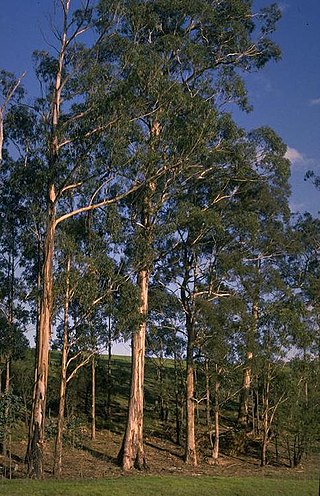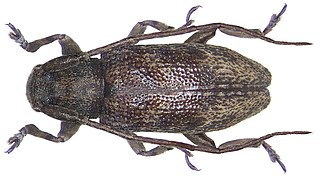
Eucalyptus globulus, commonly known as southern blue gum or blue gum, is a species of flowering plant in the family Myrtaceae. It is a tall, evergreen tree endemic to southeastern Australia. This Eucalyptus species has mostly smooth bark, juvenile leaves that are whitish and waxy on the lower surface, glossy green, lance-shaped adult leaves, glaucous, ribbed flower buds arranged singly or in groups of three or seven in leaf axils, white flowers and woody fruit.

Eucalyptus globulus subsp. bicostata, commonly known as the southern blue gum, eurabbie, blue gum or Victorian blue gum, is a subspecies of tree that is endemic to south-eastern Australia. It has mostly smooth bark with some persistent slabs of old bark at the base, juvenile leaves with one glaucous side, glossy, lance-shaped adult leaves, warty flower buds in groups of three, white flowers and hemispherical to conical fruit.

Ropica Górna is a village in the administrative district of Gmina Sękowa, within Gorlice County, Lesser Poland Voivodeship, in southern Poland, close to the border with Slovakia. It lies approximately 4 kilometres (2 mi) east of Sękowa, 9 km (6 mi) south-east of Gorlice, and 108 km (67 mi) south-east of the regional capital Kraków.

Margarya bicostata is a species of large operculate freshwater snail, an aquatic gastropod mollusk in the family Viviparidae, the river snails.
Blue gum is a common name for subspecies or the species in Eucalyptus globulus complex, and also a number of other species of Eucalyptus in Australia. In Queensland, it usually refers to Eucalyptus tereticornis, which is known elsewhere as forest red gum.
The Black Andrew Nature Reserve is a protected nature reserve located on the south west slopes of New South Wales, Australia. The 1,559-hectare (3,850-acre) reserve is situated on the southern shore of Burrinjuck Dam on the Murrumbidgee River, an important reservoir for the Murrumbidgee Irrigation Area.
Morchella bicostata is a species of fungus in the family Morchellaceae. It is found in southwestern China.
Lirularia bicostata is a species of sea snail, a marine gastropod mollusk in the family Trochidae, the top snails.

Ropica is a genus of beetles in the family Cerambycidae, containing the following species:
Ropica longula is a species of beetle in the family Cerambycidae. It was described by Breuning in 1939.
Ropica marmorata is a species of beetle in the family Cerambycidae. It was described by Breuning in 1939. It contains the subspecies Ropica marmorata marmorata and Ropica marmorata sarawakiana.
Ropica salomonum is a species of beetle in the family Cerambycidae. It was described by Breuning in 1939.
Ropica rosti is a species of beetle in the family Cerambycidae. It was described by Breuning in 1958.
Ropica sechellarum is a species of beetle in the family Cerambycidae. It was described by Breuning in 1957. It contains the subspecies Ropica sechellarum interruptefasciata and Ropica sechellarum sechellarum.
Ropica uniformis is a species of beetle in the family Cerambycidae. It was described by Breuning in 1948.
Ropica sublineata is a species of beetle in the family Cerambycidae. It was described by Gressitt in 1940.
Ropica formosana is a species of beetle in the family Cerambycidae. It was described by Henry Walter Bates in 1866. It contains four subspecies, Ropica formosana formosana, Ropica formosana japonica, Ropica formosana nobuoi, and Ropica formosana tokaraensis.

Anularya is a genus of large operculate freshwater snails, aquatic gastropod molluscs in the family Viviparidae.
Pterolophia bicostata is a species of beetle in the family Cerambycidae. It was described by Stephan von Breuning in 1943.





